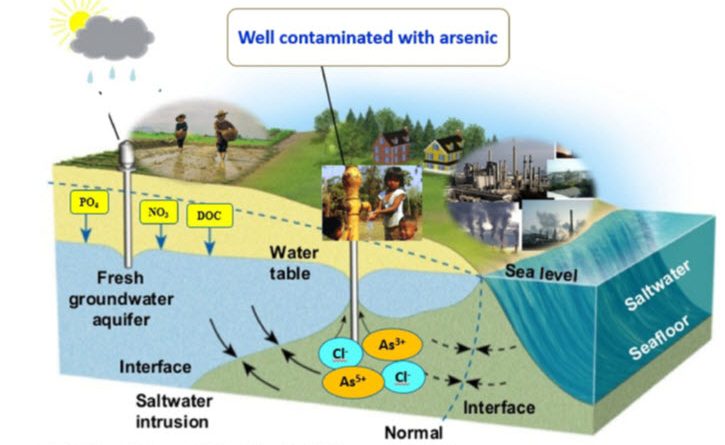Highlight Activities: Mechanisms of arsenic contamination associated with hydrochemical characteristics in coastal alluvial aquifers using multivariate statistical technique and hydrogeochemical modeling: a case study in Rayong province, eastern Thailand
Mechanisms of arsenic contamination associated with hydrochemical characteristics in coastal alluvial aquifers using multivariate statistical technique and hydrogeochemical modeling: a case study in Rayong province, eastern Thailand
The rapid development ofRayong Province has resulted in increased demands on groundwater usage. This has potentially induced the release of contaminants such as arsenic (As), among others (i.e., NO3–, PO43-) from various land use types—especially in intensive agricultural areas and heavy industrial areas, including landfill sites. The objectives of this research are to investigate the As speciation and groundwater chemistry occurring due to different hydrogeological settings and the influence of human activities and to explain the mechanism of As release in the coastal alluvial aquifers in Rayong Province using multivariate statistical techniques and hydrogeochemical modeling (PHREEQC). Six major water facies, mainly consisting of Ca–Na–HCO3–Cl and Ca–Na–Cl, were included in the hydrochemical analysis. Arsenic levels were inversely correlated with NO3–, SO42-, DO, and ORP, confirming the reducing environment in the groundwater system. The results from the PHREEQC model show that most wells were strongly under-supersaturated with respect to arsenorite, scorodite, and arsenic pentoxide. Arsenic (As) is probably derived from the dissolution of Fe oxide and hydroxide (i.e., Fe(OH)3, goethite, maghemite, and magnetite). The multivariate statistical techniques revealed that the As species mainly consisted of As(III), governed by the reducing environment, while As(V) may be desorbed from Fe oxide and hydroxide as the pH increases. Anthropogenic inputs and intensive pumping may enhance the reducing environment, facilitating the release of As(III) into the groundwater. The knowledge gained from this study helps to better understand the mechanisms of As contamination in coastal groundwater aquifers, which is useful for groundwater management, including the optimum pumping rate and long term monitoring of groundwater quality.
ข้อมูลเพิ่มเติม
Boonkaewwan S, Sonthiphand P, Chotpantarat S (2020) Mechanisms of arsenic contamination associated with hydrochemical characteristics in coastal alluvial aquifers using multivariate statistical technique and hydrogeochemical modeling: a case study in Rayong Province, Eastern Thailand. Environ Geochem Health https://doi.org/10.1007/s10653-020-00728-7
ผลงานที่ตีพิมพ์มีความเชื่อมโยงกับเป้าหมาย SDGs เป้าหมายที่ 6: สร้างหลักประกันเรื่องน้ำและการสุขาภิบาลให้มีการจัดการอย่างยั่งยืน และมีสภาพพร้อมใช้สำหรับทุกคน หัวข้อย่อยที่ 6.3 ปรับปรุงคุณภาพน้ำ โดยการลดมลพิษ ขจัดการทิ้งขยะและลดการปล่อยสารเคมีอันตรายและวัสถุอันตราย ลดสัดส่วนน้ำเสียที่ไม่ผ่านกระบวนการลงครึ่งหนึ่ง และเพิ่มการนำกลับมาใช้ใหม่และการใช้ซ้ำที่ปลอดภัยอย่างยั่งยืนทั่วโลก ภายในปี 2573

